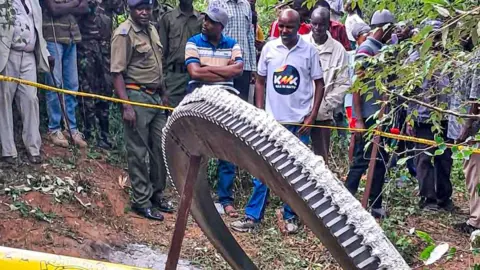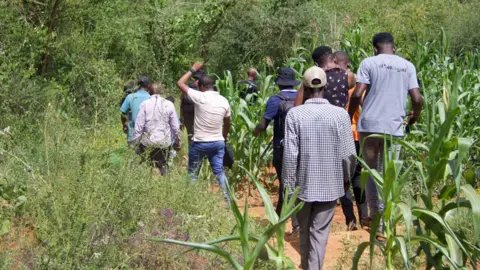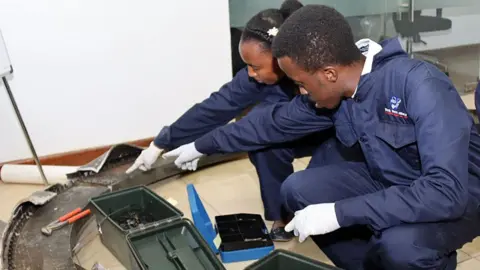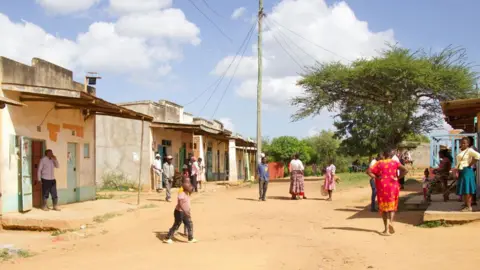Is it a bomb? Is it a plane crash? No, it’s space junk.
 Getty Images
Getty ImagesAfter a loud bang, a terrifying screeching sound startled Kenyan villagers who were relaxing with family and friends one afternoon.
Stephen Mangoka, a 75-year-old farmer from Mukuku village in Makweni County, said: “It sounded like a bomb. I panicked, I started looking around, thinking it was gunshots.
“I looked up at the sky to see if there was smoke. Nothing.
“I rushed to the road to see if there was any danger. Nothing else. That’s when someone told me something had fallen from the sky.”
Sure enough, a huge metal object had fallen from above and landed on farmland next to a dry riverbed – and it was piping hot.
“We found a big piece of metal that was very red so we had to wait for it to cool down before anyone approached,” said Ann Kanuna, who owns the land where the object fell.
The giant ring took about two hours to cool and shrink – but it’s already causing a stir as people come to see it.
The rest of that Monday afternoon – when few people were working as it was before New Year’s Eve – many people came to see the giant metal ring.
It was like selfie central, with people coming over to take pictures and great debates about what could have been.
Local authorities in Makuni County, 115 km (70 miles) southeast of the capital Nairobi, have been notified.
The Kenya Space Agency (KSA) heard about the matter and made arrangements to come and investigate the next day.
But it was the item’s reputation that Mukuku villagers feared would be stolen overnight.
A few of them, along with the local officers, took turns to stand guard and light a nearby fire. They wanted to keep away merchants and others who could make money out of their greed.
Its weight is said to be over 500 kg (1,102 lb) – the same as an adult horse – and its diameter is around 2.5 m (8 ft), the size of a child’s four-seater merry-go-round.
A large crowd of spectators arrived in broad daylight on New Year’s Eve – followed by the KSA team and media.
 Peter Njoroge / BBC
Peter Njoroge / BBCMukuku had never seen such a move. On that day, when the goods carried by the KSA were taken away, the noise raised alarm among the villagers.
KSA’s preliminary assessment showed the object was an “identification ring” from a space launch rocket.
The statement said the following day: “Such objects are typically intended to burn up as they enter the Earth’s atmosphere or fall into unoccupied areas such as oceans.”
Although no one was injured in the fall, some residents of Mukuku town began to complain that the impact of the accident caused damage to nearby houses.
Christine Kionga, who lives about a kilometer away from the accident site, showed us cracks in the concrete of some of the buildings in her compound. She said they came after the accident.
Other neighbors also said the structural integrity of their homes was damaged – allegations that have yet to be confirmed.
Benson Mutuku, a resident of Mukuku, told the BBC: “The government should find the owners of these items and compensate the victims.”
Local media reported that some residents felt better after being exposed to the metal ring and started complaining; Although there was no confirmation from the people we spoke to during our visit – neither from the authorities nor from the KSA.
However, Mr Mutuku said there were concerns about the long-term effects of possible cosmic rays.
“This is a space thing and we have heard in other similar cases that the effects of radiation will affect even future generations and there is fear in this community.”
However, later tests by Kenya’s Nuclear Regulatory Authority found that the metal rings had higher levels of radiation than the area where they were found, but were not harmful to humans.
 Peter Njoroge / BBC
Peter Njoroge / BBCEngineers at the KSA, which was established in 2017 to promote, coordinate and monitor space-related activities in East Africa, continue to conduct other experiments to learn more about it.
Director General of KSA said it was lucky that there were no injuries when the object hit the ground.
“The ultimate responsibility for any damage or injury in space rests with the jurisdiction where the operator launched the object,” Brigadier Hilary Kipkosgei told the BBC.
According to the Outer Space Treaty, which is overseen by the United Nations Office of Foreign Affairs, “States are responsible for damage caused in outer space”.
“(The ring) is common in many rockets and many spacecraft so it’s difficult to link it to a specific rocket or spacecraft, but we have leads, but as I said, our investigations are inconclusive,” Brigadier Kipkosge said.
The BBC showed the footage to the UK’s space agency to get the experts’ opinion.
“The most plausible thing this could be is the upper stage identification ring from the 2008 Ariane rocket,” said launch director Matt Archer.
“The satellites are fine, but the actual rocket body has passed and has been destroyed.”
Ariane was Europe’s main rocket launch vehicle, helping more than 230 satellites into orbit before being retired in 2023.
It seems that the tag ring had been roaming the earth for 16 years before it unexpectedly appeared in Mukuku.
This is not the first time that space debris has occurred in East Africa.
A year and a half ago, some suspected space debris fell on several villages in western Uganda.
And a few days ago, on January 8, there were unconfirmed reports of space debris burning brightly in the skies above northern Kenya and southern Ethiopia.
 Peter Njoroge / BBC
Peter Njoroge / BBCThey predict that as the space industry grows, such accidents will become more common – and African governments should invest in better ways to deal with this rapidly growing space junk.
NASA estimates that there are currently more than 6,000 tons of space debris.
There are many different estimates of the probability of hitting someone. But most are in the 1-10,000 range..
Such figures are of little comfort to the residents of Mukuku, considering what damage the ring could have caused if it had landed in the middle of the village instead of on farmland.
“We want assurances from the government that it will not happen again,” Mr Mutuku said.
You may also be interested in:
 Getty Images/BBC
Getty Images/BBC2025-01-12 00:29:09
https://ichef.bbci.co.uk/news/1024/branded_news/5ee8/live/3b3d87f0-cf7b-11ef-94cb-5f844ceb9e30.jpg








